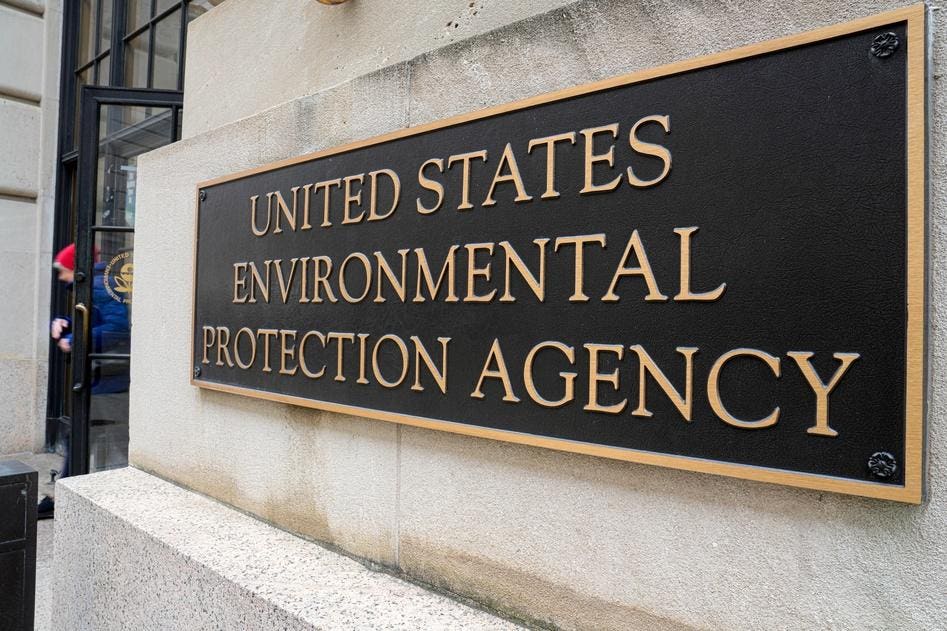WASHINGTON, DC – JANUARY 30: A bronze sign marks an entrance to the US Environmental Protection … More
In a sweeping move today, the Environmental Protection Agency has sought to undo the legal scaffolding for confronting climate change. EPA head Lee Zeldin announced that the agency would forge ahead with a proposal to repeal the “endangerment finding,” a rule established in 2009 that enables the regulation of greenhouse gas emissions vis-à-vis the Clean Air Act.
The Trump-era EPA had set its sights on the endangerment finding at least as early as March, when the agency unveiled “31 historic actions in the greatest and most consequential day of deregulation in U.S. history.” These actions, a set of large-scale environmental rollbacks, included a call for “reconsideration of the 2009 Endangerment Finding and regulations and actions that rely on that Finding.”
The endangerment finding comprises two key parts, both explicitly centered around “public health and welfare.” The first clause states that the increased atmospheric levels of six greenhouse gases imperil humanity’s well-being, and the second clause specifically implicates new motor vehicles and their engines for helping drive harmful pollution by way of these emissions.
In an interview on Fox News, Administrator Zeldin provided further context on the EPA’s new proposal to gut the endangerment finding, saying, “We’re not going to go along with applying extreme economic pain on Americans who can least afford it.”
He also provided a characterization of the opposition to the proposal, noting, “There’s going to be a lot of hyperbole, scare tactics, extreme rhetoric that will come from climate zealots.”
Indeed, that the EPA would seek to unravel the endangerment finding is part and parcel with President Trump’s longstanding portrayal of climate action as a policy nuisance and economic impediment. The administration’s storyline has repeatedly set up a binary between climate action and economic prosperity, painting advocates of the former as indifferent to the latter.
In fact, on his first day in office, when President Trump sought to extricate the U.S. from the Paris Agreement for a second time, he issued an executive order that reinforced the economic framing, stating, “It is the policy of my Administration to put the interests of the United States and the American people first in the development and negotiation of any international agreements with the potential to damage or stifle the American economy.”
But the facts remind us that viewing climate action as a zero-sum game with economic growth is counterproductive on several fronts.
First, the explosion of renewable energy capacity means that forfeiting the opportunity to be at the vanguard of this global movement is a veritable disservice to economic prospects. While the Trump administration has sought to stifle clean energy commitments in favor of unleashing fossil fuels, other countries are taking note and expanding investments in renewables research and technologies that promise to define the future.
Moreover, the notion that reigning in greenhouse gas emissions undermines economic prosperity overlooks the mountain of evidence that the climate crisis is injurious to public health, a reality that the endangerment finding acknowledged and sought to address.
For example, this summer alone, millions of Americans have sweltered under extreme heat, with climate change being implicated in the greater “intensity, frequency and duration” of heatwaves. Several studies have attempted to quantify the economic disruption wrought by heat, with the estimates including some $100 billion or 2.5 billion hours of labor.
Children are especially vulnerable to high heat and have logged learning losses when schools are ill-fitted with sufficient cooling measures. Elementary and middle school students in multiple states have historically seen their school days cut short when the temperatures pose unmitigable risk.
While the Biden administration had compiled a comprehensive National Heat Strategy to begin counteracting these widespread effects, it’s safe to say that, in the current moment, a robust response of comparable magnitude appears to be all but lacking. This means that not only are we presently failing to scale up adaptations to the downstream effects of unchecked greenhouse gas emissions, but we’re also torpedoing our preventative stopgap by targeting the endangerment finding.
And this is just one facet of how the climate crisis and public health are intertwined and why regulating greenhouse gas emissions is core to breaking this cycle. This is to say nothing of wildfires, floods, tropical cyclones, allergy seasons, infectious disease transmission, food insecurity, and associated mental health impacts that are reshaping life on a climate change-stricken planet.
From this cascade, the World Health Organization projects 250,000 more annual fatalities from 2030 to 2050, as well as $2-4 billion in annual health expenses by the next 5 years. Just last year, the U.S. suffered more than $182 billion in losses from weather and climate-related catastrophes. The images of victims of Hurricane Helene, which decimated homes and left people without clean water for weeks, are still searing.
The EPA’s proposal to reverse course on a critical tool for combating climate change will have far-reaching consequences. “The public health and welfare of current and future generations,” a prescient phrase from the text of the endangerment finding, will be squarely among them.









